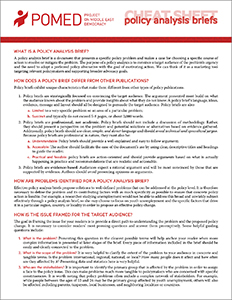For an English PDF of this quick read, click here.
For an Arabic PDF of this quick read, click here.

WHAT IS A POLICY ANALYSIS BRIEF?
A policy analysis brief is a document that presents a specific policy problem and makes a case for choosing a specific course of action to resolve or mitigate the problem. The purpose of a policy analysis is to convince a target audience of the problem’s urgency and the need to adopt a preferred policy alternative with the goal of motivating action. We can think of it as a marketing tool targeting relevant policymakers and supporting broader advocacy goals.
HOW DOES A POLICY BRIEF DIFFER FROM OTHER PUBLICATIONS?
Policy briefs exhibit unique characteristics that make them different from other types of policy publications.
- Policy briefs are strategically focused on convincing the target audience. The argument presented must build on what the audience knows about the problem and provide insights about what they do not know. A policy brief’s language, ideas, evidence, message and layout should all be designed to persuade the target audience. Policy briefs are also:
- Limited to a very specific problem or an area of a particular problem;
- Succinct and typically do not exceed 5-8 pages, or about 3,000 words.
- Policy briefs are professional, not academic. Policy briefs should not include a discussion of methodology. Rather, they should present a perspective on the problem and potential solutions or alternatives based on evidence gathered. Additionally, policy briefs should use clear, simple, and direct language and should avoid technical and specialized jargon. Because policy briefs are professional in nature, they must also be:
- Understandable: Policy briefs should provide a well-explained and easy to follow argument;
- Accessible: The author should facilitate the ease of the document’s use by using clear, descriptive titles and headings to guide the reader;
- Practical and feasible: policy briefs are action-oriented and should provide arguments based on what is actually happening in practice and recommendations that are realistic and actionable.
- Policy briefs are evidence-based. Audiences expect a rational argument and will be most convinced by those that are supported by evidence. Authors should avoid presenting opinions as arguments.
HOW ARE PROBLEMS IDENTIFIED FOR A POLICY ANALYSIS BRIEF?
Effective policy analysis briefs propose solutions to well-defined problems that can be addressed at the policy level. It is therefore necessary to define the problem and its contributing factors with as much specificity as possible to ensure that concrete policy action is feasible. For example, a researcher studying unemployment would not be able to address this broad and unwieldy subject effectively through a policy analysis brief, so she may choose to focus on youth unemployment and the specific factors that drive it in a particular region, country, or locality in order to propose an effective policy change.
HOW IS THE ISSUE FRAMED FOR THE TARGET AUDIENCE?
The goal in framing the issue for your readers is to provide a direct path to understanding the problem and the proposed policy change. It is necessary to consider readers’ most pressing questions and answer them preemptively. Some helpful guiding questions include:
- What is the problem? Presenting this question in the clearest possible terms will help anchor your reader when more complex information is presented at later stages of the brief. Every piece of information included in the brief should be easily and clearly connected to the problem.
- What is the scope of the problem? It is very helpful to clarify the extent of the problem to your audience in concrete and tangible terms. Is the problem international, regional, national, or local? How many people does it affect and how often are they affected by it? Presenting data and statistics here is very helpful.
- Who are the stakeholders? It is important to identify the primary group that is affected by the problem in order to assign a face to the policy issue. This can make problems much more tangible to policymakers who are concerned with specific constituencies. It is worth noting that policy problems often include a complex network of stakeholders. For example, while people between the ages of 15 and 24 may be the primary group affected by youth unemployment, others will also be affected including parents, taxpayers, local businesses, and neighboring localities or countries.
WHAT IS THE STRUCTURE OF A POLICY ANALYSIS BRIEF?
Policy analysis briefs have a distinctive format to support their distinct purpose and characteristics. While they may vary somewhat, policy analysis briefs often look like this:
- Title: The title of a policy analysis brief should be compelling but must also be descriptive and relevant.
- Executive Summary: This section summarizes the contents of the policy brief and convinces the reader that it is worth further investigation. It is especially important for an audience that may often be short on time. An executive summary should not exceed two paragraphs and should answer the following questions succinctly.
- What is the problem that the policy brief will address?
- Why must the current approach be changed?
- What are your recommendations for action?
- Context & Scope of the Problem: This element of a policy analysis should convince the target audience that an urgent problem exists that requires attention and action. The context of the problem and its importance is the primary building block for subsequent sections of the brief. It is imperative that this section present a clear and succinct problem definition, which includes:
-
A problem statement:
-
What is the problem?
-
Who does it affect?
-
What is the scale and scope of the problem?
-
-
Contributing factors:
-
What are the root causes of the problem?
-
Are there factors that exacerbate or improve the problem?
-
-
Policy implications:
-
Why must we address this problem?
-
Why must the problem be addressed now?
-
-
- Critique of the Current Approach: In this section of a policy analysis brief, policy analysts should detail the shortcomings of the current approach, if any, and illustrate the need for change and where that change needs to occur. To ensure credibility, it is important to recognize a variety of opinions in the debate of the issue. It may be helpful to consider the following guiding questions:
-
What is the current approach to the problem?
-
Why is the current approach failing? Who is it failing? How is it failing?
-
What would happen if we did not change the current approach?
-
- Policy Alternatives: Here, policy analysts have the opportunity to present proposed policy alternatives, or other options to address the problem. It should be fair, accurate and driven by evidence and data, as well as by the problem definition. This section strives to convince readers that the policy action proposed in the brief is the most desirable. Consider the following:
-
Do the root causes of the problem present potential entry points for resolving or mitigating the issue?
-
What are some of the generic policies that can be adopted to remedy the problem?
-
Which criteria are most important to us in resolving the problem? What values are being used to evaluate policy outcomes? What are we trying to achieve?
-
- Policy Recommendations: This section contains detailed explanations of concrete and actionable steps that are recommended for addressing the policy issue. In developing this element of a policy analysis, it is worth considering:
-
What are policymakers and decision makers being asked to do, specifically?
-
What goals would you like them to achieve?
-
Are your policy recommendations specific, measurable, achievable, and relevant?
-
What is the timeline for their implementation?
-
This section may also include a closing paragraph to emphasize the importance of taking action and urging the audience to take your recommendations.
-
- Appendices: If necessary and relevant, an appendix may be included to provide further support, data, or evidence.
- Consulted or Recommended Sources: While policy analysis briefs are not academic in nature, it is important to include sources for data or information used. This is important for transparency and credibility, but is also an opportunity to lead the audience to further reading on the issue.




|
President Trump is Undermining Foreign Aid Transparency and Accountability